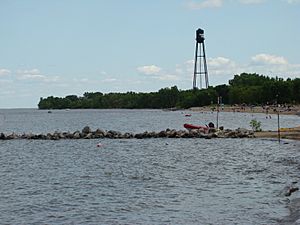Lake Winnipeg facts for kids
Lake Winnipeg is a very large lake located in the province of Manitoba, Canada. It sits just north of the city of Winnipeg. This amazing lake is the biggest one in southern Canada and the eleventh largest freshwater lake on Earth!
Contents
About Lake Winnipeg
Lake Winnipeg is a huge, shallow lake that stretches for about 416 kilometers (258 miles) from north to south. Even though it's so long, it's quite shallow, with an average depth of only 12 meters (39 feet). Its deepest point is about 36 meters (118 feet) deep.
How Big Is It?
The lake covers an area of about 24,514 square kilometers (9,465 square miles). That's bigger than some countries! It's so big that you can't see the other side when you're standing on its shore. The lake holds a massive amount of water, about 284 cubic kilometers (68 cubic miles).
Where Does the Water Come From?
Lake Winnipeg gets its water from a huge area called a drainage basin. This basin covers almost one million square kilometers (386,000 square miles). It includes parts of four Canadian provinces and four U.S. states! Major rivers like the Saskatchewan River, Red River, and Winnipeg River all flow into Lake Winnipeg. The water then flows out through the Nelson River, which eventually reaches Hudson Bay.
Wildlife and Nature
Lake Winnipeg is home to many different kinds of plants and animals. It's a really important place for nature.
Fish and Other Water Creatures
The lake is full of fish, including walleye, perch, northern pike, and whitefish. Many people enjoy fishing here. You might also spot other creatures like freshwater sponges and different types of insects living in the water.
Birds and Land Animals
Many birds use Lake Winnipeg as a resting spot during their long migrations. You can see pelicans, gulls, and various ducks and geese. The areas around the lake, including islands like Hecla Island, are home to animals like moose, deer, and many smaller mammals.
History and People
People have lived around Lake Winnipeg for thousands of years. It has always been an important place for travel, trade, and food.
First Peoples
Long before European explorers arrived, Indigenous peoples like the Anishinaabe, Cree, and Métis lived by the lake. They used its waters for fishing and transportation, and the land for hunting and gathering. The lake was a central part of their lives and cultures.
European Exploration
European explorers first reached Lake Winnipeg in the late 1600s. They were looking for new trade routes and resources, especially furs. The lake became a key part of the fur trade network, with trading posts set up along its shores. The Hudson's Bay Company and the North West Company were very active here.
Modern Communities
Today, many towns and communities are located along the shores of Lake Winnipeg. Places like Gimli, Winnipeg Beach, and Grand Beach are popular spots for tourists, especially in the summer. People come to enjoy the beaches, fishing, and boating.
Environmental Concerns
Even though Lake Winnipeg is big and beautiful, it faces some serious environmental challenges.
Algae Blooms
One of the biggest problems is the growth of large amounts of algae, called "algae blooms." These blooms can make the water look green and murky. They are caused by too many nutrients, like phosphorus and nitrogen, entering the lake from farms, cities, and other sources.
Protecting the Lake
Algae blooms can harm fish and other wildlife by reducing oxygen in the water. They can also make the lake less enjoyable for swimming and recreation. Many groups are working hard to protect Lake Winnipeg. They are trying to reduce pollution and improve the health of the lake for future generations. This includes efforts to manage wastewater and improve farming practices in the surrounding areas.
Images for kids
-
NASA false-colour image of Lake Winnipeg
See also
 In Spanish: Lago Winnipeg para niños
In Spanish: Lago Winnipeg para niños





